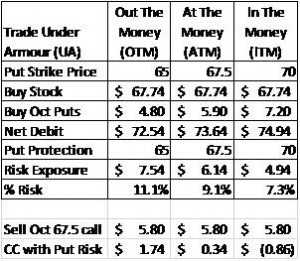One of the basic mistakes that new covered call traders make is that they trade for the highest premium available to maximize their monthly income without looking at the amount of risk they are taking on with this type of trade. When option premiums are high there is a reason for the increase in option pricing because of some uncertainty or increased risks. The advanced covered call trader knows this and uses a protective put to manage their risk of loss on a high volatility trade.
The classic strategy is protect a position is to buy a put which is referred to as a “protective put.” With a put buy you have the right (but no obligation) to sell a stock at the strike price of the put. The protective put allows the stock owner to keep the stock but limits the amount of downsize to a lower stock price at the put’s strike price. The stock owner no longer has price risk once the stock price falls below the put strike price as they can sell the stock at the put strike price before the option expires.
Stock investors refer to a put as price insurance as the cost of buying a put is similar to paying an insurance premium and the ownership of the put is
the insurance policy. The management of stock price insurance is an additional cost to the trade. For covered call investors, they must determine if it is worthwhile to buy the put as it will affect their monthly income plan. The amount of buying a put depends on the amount of time before expiration, the strike price and the implied volatility of the put. As you know, as volatility increases then option prices will tend to increase as well.
The table below shows an example trade with Under Armour (UA). The stock is trading at $67.74 per share. This example displays buying a put for protection at three strike prices: ITM, ATM & OTM. As shown, the more in-the-money (ITM) the put then the more protection in stock price and less risk exposure in dollar terms. The risk exposure is calculated by subtracting the put strike price from the net debit (share price + put cost).
The bottom two rows in the table show selling an ATM October call of 67.5 on UA. You will receive $5.80 in premium for every call sold. If you subtract this call premium from the risk exposure shown in the top portion of the table, you get the total risk exposure of the covered call with protective put trade.
Again – the more ITM the trade, the less risk exposure. This example assumes the protective put strike price comes into play. Of course, you would not usually use this strategy in a bull market as it is more effective during bear markets with increased levels of uncertainty. You can also play what-if by using different
expiration months for the protective put.

